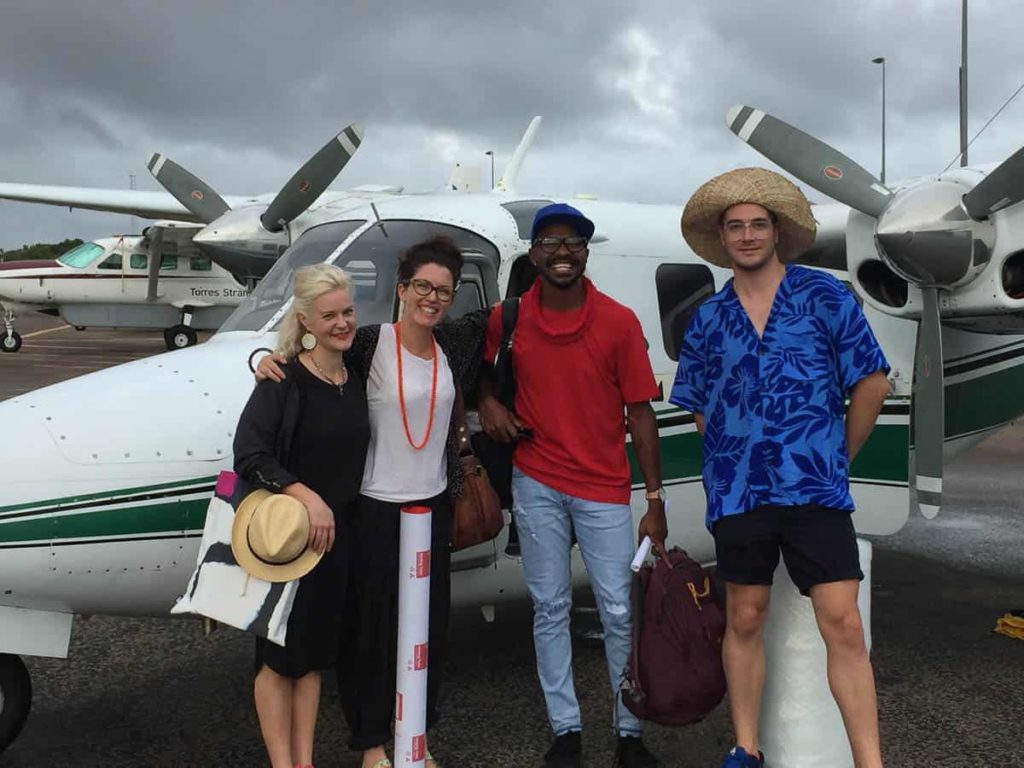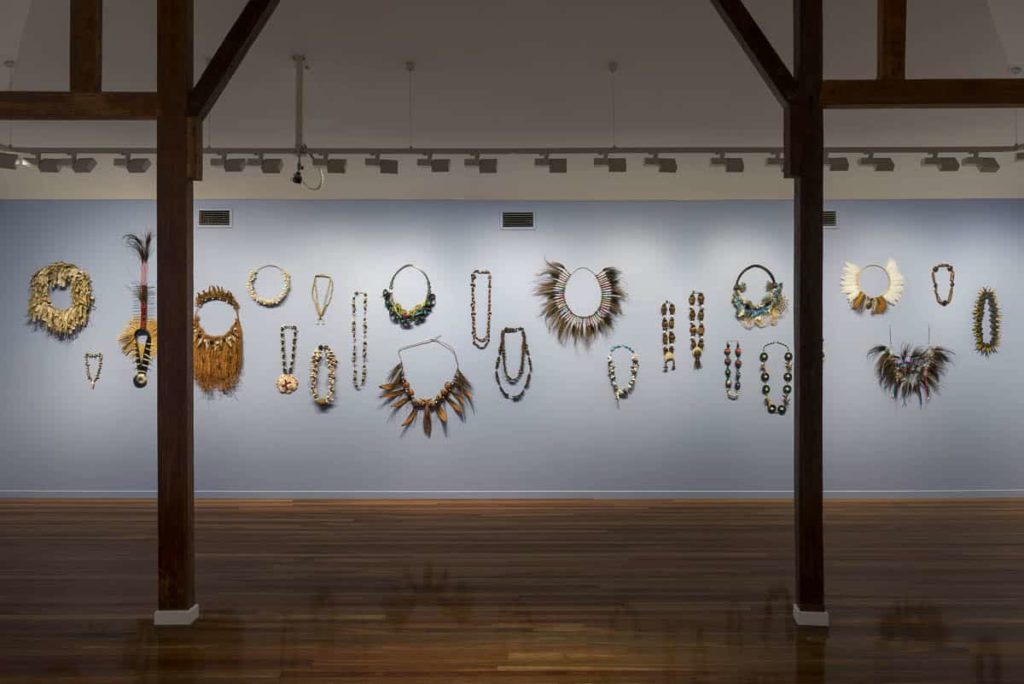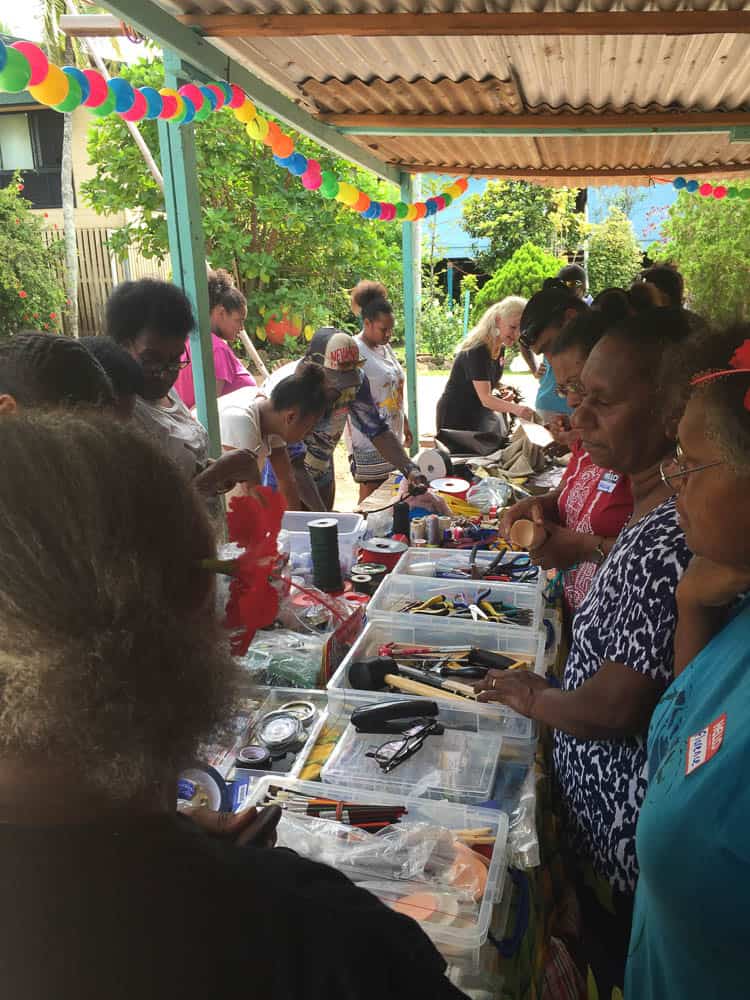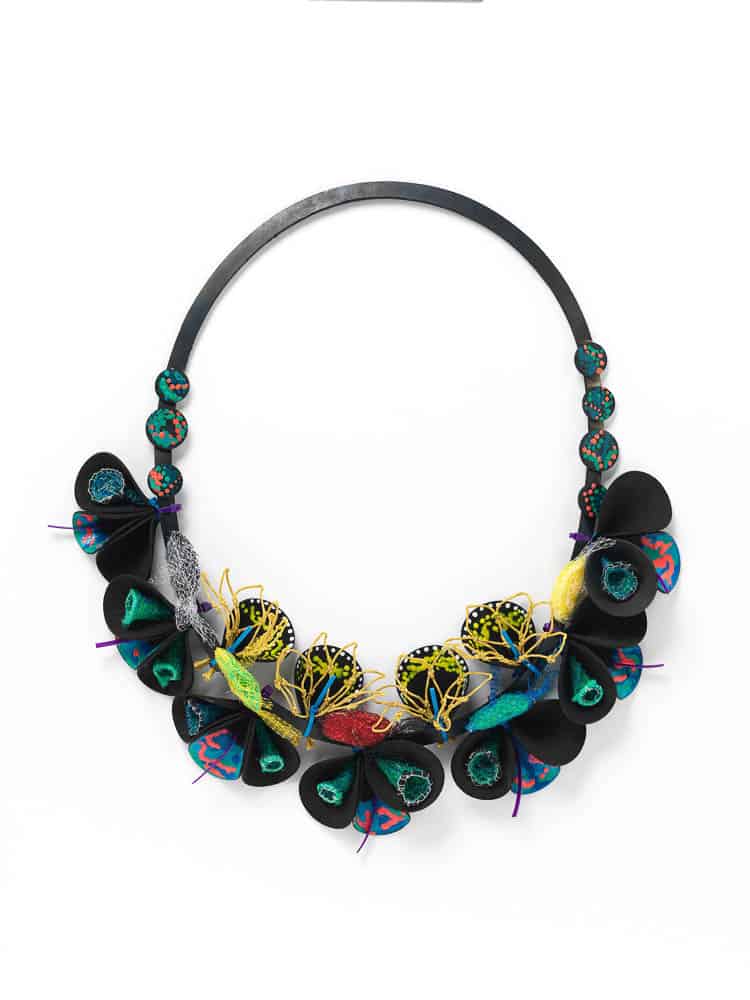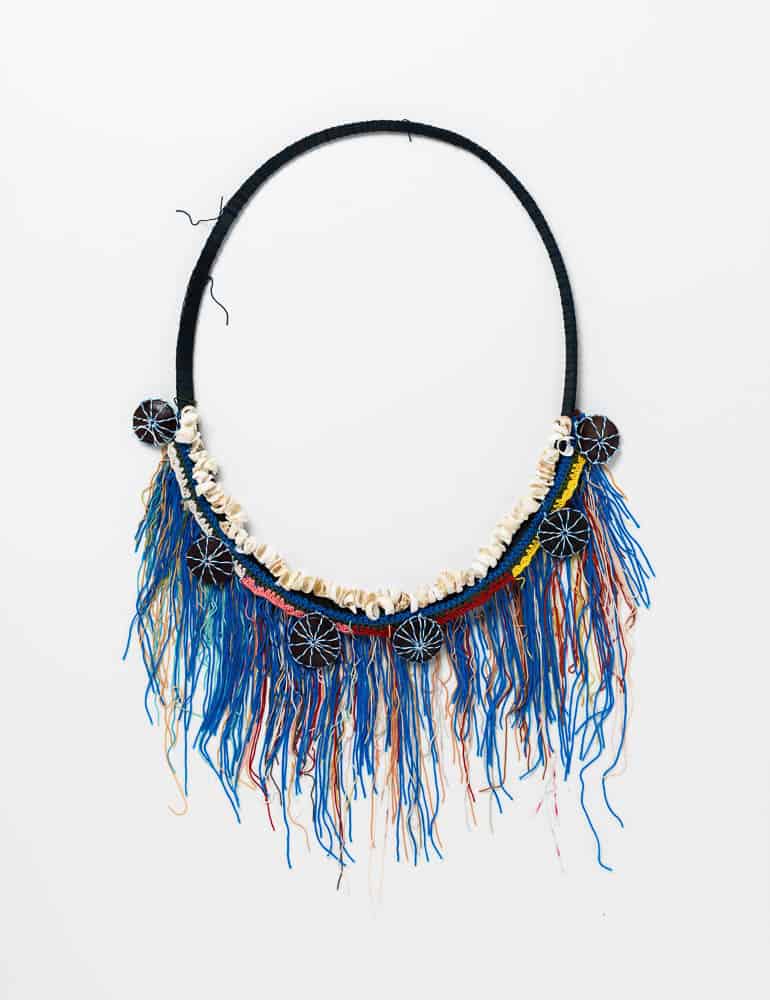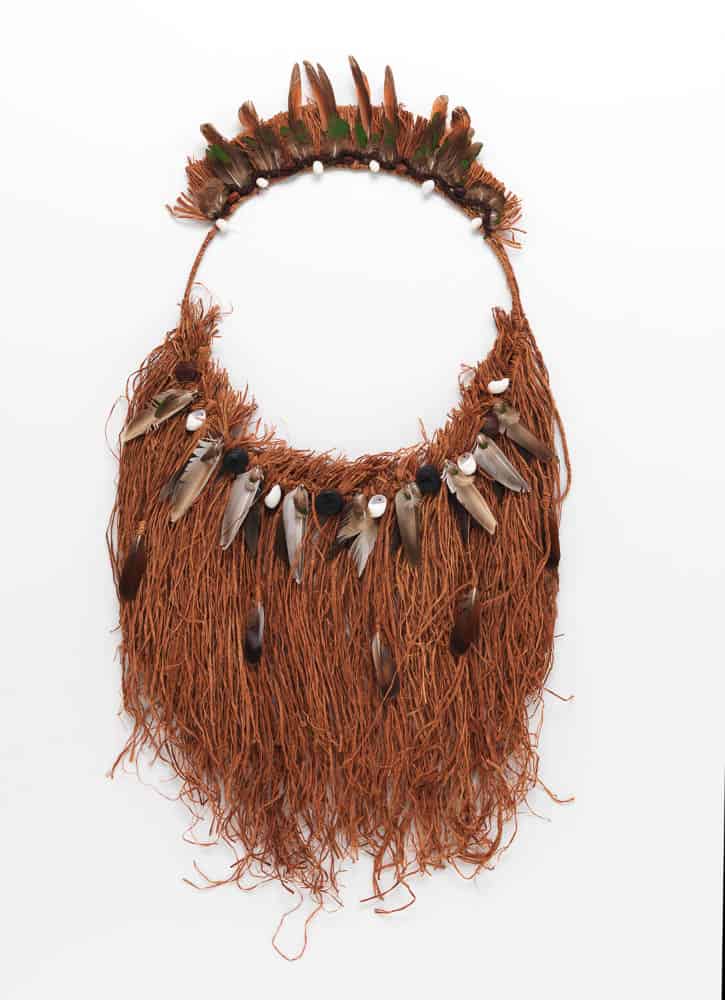- Simone LeAmon, Curator of Contemporary Design and Architecture (NGV), Torres Strait Islander artist, dancer and cultural attaché Hans Ahwang, Ashleigh Campbell Curator (CAG) and Myles Russell-Cook, Curator of Indigenous Art (NGV)
- Installation view, Lei it on, Cairns Art Gallery 2017. Photo Michael Marzik
- Lei it on install, Cairns Art Gallery 2017. Photo Michael Marzik
“You know people like it goes back years and years and years to pre-contact time, people would adorn their bodies. It is part of beautifying, tattoos, hair pieces and neckpieces and armpieces. They even used clay and body paint. Then when you perform you wear it all. It is like exhibiting your personal and your cultural self. People use their body adornment to become something else. You are capturing the audience. It is spiritual and social and creative. When you wear the body adornment, you capture people. It is art and dance and making ornaments to adorn your bodies.” Mariana Babia, Arts and Cultural Officer, Saibai, March 2017
As part of a curatorial project developed by the National Gallery of Victoria (NGV) and Cairns Art Gallery (CAG) in association with Gab Titui Cultural Centre, an exciting new collection of contemporary lei and body adornment from throughout the Torres Strait Islands was produced between March and April 2017. Delivering the workshops on behalf of the NGV and CAG, was Simone LeAmon, Curator of Contemporary Design and Architecture (NGV), Myles Russell-Cook, Curator of Indigenous Art (NGV), Ashleigh Campbell Curator (CAG), and Torres Strait Islander artist, dancer and cultural attaché Hans Ahwang. Together, the team facilitated a series of artist-led workshops on Thursday Island, Saibai, Erub (Darnley Island), Mer (Murray Island), Mua (Moa Island) and Badu, where communities came together to make and explore their artistic practice. In each workshop, participants produced unique body adornment inspired by the idea of the lei.
Participants incorporated both customary materials such as shells, feathers, seeds, pandanus, sedge grasses, and bamboo as well as contemporary and recycled materials including copper, silver, nylon, rubber, canvas and silk thread. Each of the works produced offers a unique snapshot as to the breadth and diversity of cultural practices unique throughout the Torres Strait.
The project provided a vital exchange of knowledge between artists and curators, and through the workshop model created a deeper understanding of the shared cultures and identities throughout the Torres Strait. The culmination of this work was a magnificent collection of lei ranging from large-scale sculptural wall hangings, to intimate and delicate wearable pieces produced by fifty-three artists to be acquired for the permanent collections at both NGV and CAG. As a highlight of the city-wide programming for the Cairns Indigenous Art Fair 2017, more than forty of these works appeared in the exhibition Lei it on at the Cairns Art Gallery from 24 June – 27 October.
Upon hearing of this ambitious collaborative project, Garland asked Simone LeAmon to share her Torres Strait Island diary.
The journey to Torres Strait
Leading up to my departure for the Torres Strait Islands (TSI) I gathered 700kg of hand tools and materials. Frequenting art, haberdashery, jewellery and fishing supply stores, I felt like the human equivalent of a bowerbird. I packed the kits, and sent them up north. Travelling by road, air and sea, the six workshop kits arrived with our project partner Gab Titui Cultural Centre on Thursday Island, Friday 24 March. At this stage I don’t think any of us realised just how important these kits would be.
The Torres Strait Islands lie between the tip of Australia’s Cape York Peninsula and Papua New Guinea. They are an archipelago of 274 small islands, with a population of 5,000 plus people who live on twenty-two of those islands. Culturally, Torres Strait is astonishingly diverse, comprising of five distinct groups—the top western, near western, inner, central and eastern islands. There are two traditional languages spoken in Torres Strait, Meriam Mer and Kala Lagaw Ya, however, most people we met spoke their native language, English, and Creole, which is a funky mix of English language and their indigenous tongue.
Thursday Island
Ashleigh, Myles, Hans and I checked-in to the Grand Hotel on Thursday Island (TI) on Sunday 26 March. The administrative hub of the Torres Strait, TI is home to the Kaurareg nation. Excited to see Leitha Assan, exhibitions and operations manager at Gab Titui, we reviewed the twenty-one-day travel and workshop schedule and planned for contingencies. We are as organised as we can be. If things go pear shape we’ll just have to improvise.
Hans commences the TI workshop with a prayer. Soon the room is filled with stories of home, community, and family—stories which ended up informing designs for necklaces and lei. Hands at work, the array of new materials excite. Artist Rosie Ware’s (1960) Crepe copper lei re-imagines in sheet copper the crepe-paper lei she remembers her mother once made for festive occasions. Senior artist and noted weaver Wasi Tardent’s (1943) Porso lei is woven from reclaimed nylon strapping. It is inspired by a particular type of weaving she uses for cooking food in a kupmuri (ground oven). At lunch, Elder and artist Cessa Nakata (1927) sings and plays her ukulele. In the 1950s she began performing alongside her twin sister Ina Titasey and their younger sister Rita Fell-Tyrell as The Mills Sisters. Nekata’s neckpiece titled Frangipani Land is inspired by their well-known song of the same name and is a homage to her late sisters. The workshop ends with a prayer, and the artists delight in the creation of their innovative new works. It is an exhilarating and emotional experience. We shed a tear when we say goodbye.
Saibai
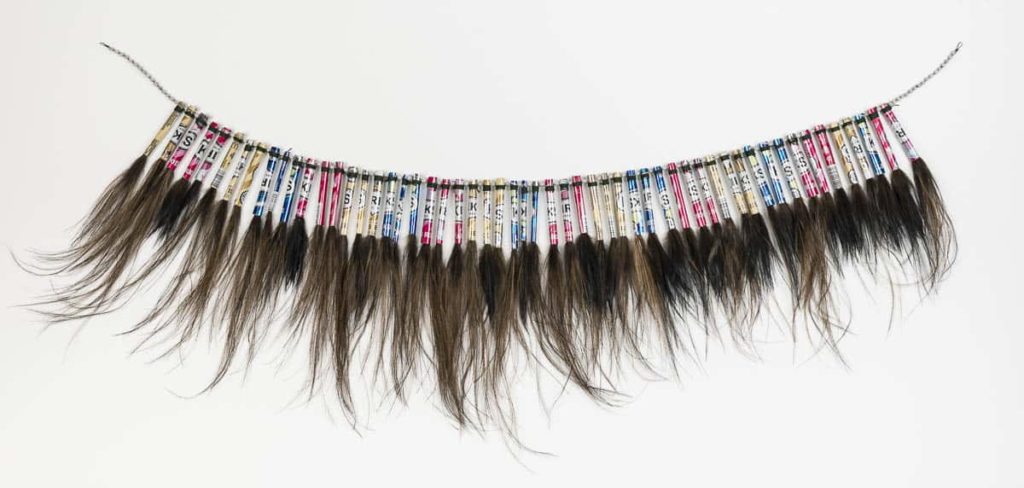
Theresa Clermont, Shirley Ewadie Daniel, Dadib Ema Ingui, Bonita Kaida
Ngalpan Buway lei (Our family lei) 2017
aluminium cans, cassowary feathers, seeds, steel cable, adhesive
93 x 100 x 1 cm (variable)
Courtesy of the National Gallery of Victoria
Photo: Michael Marzik

Mariana Babia, Kulapiw Koewsa lei II 2017, kulap seed (green), timber bead, copper tube, nylon coated trace wire, crimps. National Gallery of Victoria, Melbourne, Commission 2017
Torres Strait art and design is dynamic and innovative, but geographic isolation often impedes curators and collectors from spending time on the ground.
Walking onto the airstrip at Horn Island we see our plane. Dubbed the “workhorse” of the general aviation industry, our charter is a twin-engine aircraft with a 600 kg payload. A 1975 Aero Commander Shrike it seats 4-6 passengers. It’s tiny and looks like a Toyota Yaris with wings!
Saibai Island is 4 km from Papua New Guinea (PNG). The people on Saibai have a reputation for creating wild headdresses, masks, hand-held dance instruments and jewellery. On touch down it’s hot, very humid and dusty. Held under native title, we need to swing by the Saibai Council office to show our visitors permits. Arts and cultural officer, Mariana Babia, greets us with some bad news. She doubts the artists will come to the workshop tomorrow. A death has occurred in the community and people are observing the mourning custom—sorry business. But, she has a back-up plan. Mariana sends us sightseeing to see wild deer and a pet crocodile.
Of the 450 plus people that inhabit Saibai, many are Papuan day traders and families travelling between near and far indigenous communities. Brought together by Mariana for the workshop, Theresa Clermont (b.1996), Shirley Daniel (b.1970), Dadib Ingui (b.1980), and Bonita Kaida (b.1996) were visiting from Boigu Island, Daru and Cape York Peninsula. Collaborating on the neckpiece Ngalpan Buway lei (Our family lei), the women developed a technique for making cylindrical beads from Kirk soft drink cans, incorporating Cassowary feathers purchased from the market. Symbolising the strong ties between the people of Saibai and PNG it is a magnificent example of using materials at hand.
Before we fly-out, Conwell Nathan Tabuai (b.1982), a senior member of the Saibai dance team (Muyngu Koekaper) presents us with Kataw Za, a warrior charm necklace made from PVC piping, cable ties and nylon strapping.
Mer
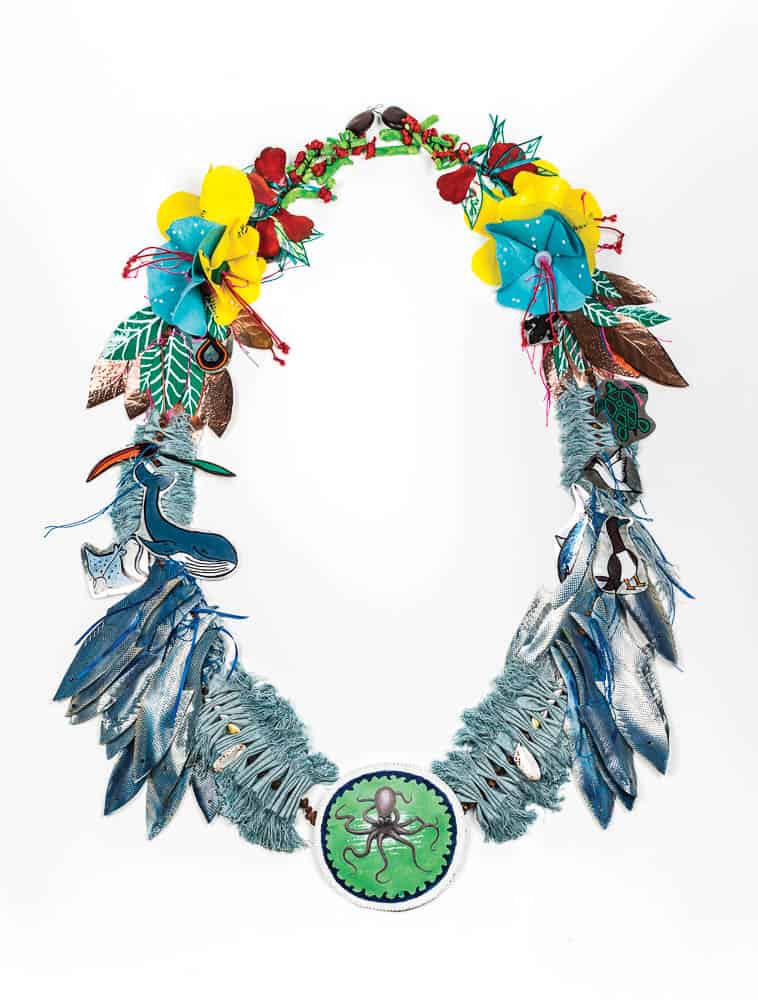
Segar Passi, Helen Dick, Garee Kaigey, Mary Kaigey, Rita Lui, Beverley Mabo, Helen Mabo,Delina Noah,
Messiah Luzab Lera Kaubo Arsir
(The whole island of Mer, making things, making lei),
2017, canvas, acrylic paint, thread, synthetic wadding, wing seed, silk linen, shell, plastic, silver sheet, enamel paint, copper sheet, copper tube, acrylic, 170 x 107 x 12 cm (variable)
National Gallery of Victoria, Melbourne, Commission 2017
Photo: Michael Marzik
A funny thing happened on the way to Mer (Murray Island). Caught between two storm fronts our pilot makes an emergency landing on Masig (Yorke Island) home to the Masigalgal people. Two hours pass and the skies finally clear. We resume our seats in the twin-engine 1960 Britten-Norman Islander—shaken but not deterred.
The home of the late Eddie Mabo, Mer was the subject of the 1992 landmark Mabo decision, inserting the legal doctrine of native title into Australian law. On our arrival, Member for Mer and Chair of Mer Gedkem Le (Torres Strait Islanders) Corporation, Aven Noah welcomes us to Country. In the late afternoon, we join him at his home on the beach, drink from coconuts and watch the sharks swim after the sardines.
The combination of many artists’ hands instilled the monumental lei made in the Mer workshop with a sense of wonderment. Near to two metres high, Messiah Luzab Lera Kaubo Arsir (The whole island of Mer, making things, making lei) is a large scale collaborative lei representing the close-knit Meriam community. It was made by Elders and artists: Segar Passi (b.1942), Helen Dick (b.1956), Garee Kaigey (b.1941), Mary Kaigey (b.1954), Rita Lui (b.1949), Beverley Mabo (b.1959), Helen Mabo (circa 1950) and Delina Noah (b.1964). The lei’s intrinsic connection to place is evident in the artist’s representation of the eight tribes of Mer and the many plant and animal species found on the island. The symbolism and meaning of the lei has been recorded by Myles. Scribbling in his notebook, he listens and asks questions. Hans interprets, clarifies and consults the community. It’s a delicate and rewarding process, ensuring the Elder’s and artist’s voices accompany the lei into the future.
Invited to church on Sunday we sing hymns and give thanks—our spirits are high. Escorted to Mabo’s grave we pay our respects. Aven farewells us at the airport and we give him our hardworking coffee plunger.
Erub
- Materials table, day 1 of the Erub workshop
- Artist Florence Gutchen working on her lei Home Reef at the Erub workshop
- Lavinia Ketchell Fish trap 2017 rubber, satin ribbon, adhesive National Gallery of Victoria, Melbourne Commission 2017
- Ellarose Savage My home reef 2017 rubber, enamel, fish net, adhesive National Gallery of Victoria, Melbourne Commission 2017
- Rion Savage Sai (Fish fence) 2017 foam, fibre aerosol paint. National Gallery of Victoria, Melbourne Commission 2017
- Maryann Sebasio Ilwer (The morning star) 2017 rubber, shell, kulap seed, thread, nylon. National Gallery of Victoria, Melbourne Commission 2017
Flying 48km North, Erub (Darnley Island) lies at the edge of the Great Barrier Reef and is home to 400 people. At 5,000ft altitude, I fire-off email reports to NGV and CAG. Internet coverage is terrible in the Torres Strait, but I get a good signal in the plane. Only 460 meters long, the airstrip on Erub is one of the shortest in Australia. Our Britten-Norman Islander has a landing run of 290 meters. The craft lands, comes to halt and we clap in relief. The pilot finds it very amusing.
Decorated with balloons and streamers, the workshop venue is an open-air structure on the Darnley waterfront. But, the festive vibe soon turns to disappointment when the place is washed out by the rain. Forced to abandon day 1 we go in search of a water-tight venue. At 8am the following morning, the artists arrive at Norah’s Guest House (where we’re staying). The accomplished artists of Erub get to work, full of purpose. Acting on ideas formed overnight, finished lei and necklaces appear by midday. Making two or more works each, the artists are creative dynamos!
Founded in the late 1990s, Erub Erwer Meta (Darnley Island Arts Centre) was the first incorporated art centre in the Torres Strait. Erub artists have been turning reclaimed materials such as fishing nets and ropes into sculpture and jewellery for over a decade. Lei created by Florence Gutchen (b.1961) Home reef and Ellarose Savage (b.1968) My home reef are indicative of the artist’s sophisticated approach to materials and making. They represent the sea using rubber, ghost net, nail varnish, plastic cable ties, pipe cleaners, thread, silver and kulap seeds.
Merging customary knowledge with industrial materials. Rion Savage’s (b.1974) Sai (Fish fence) is woven insulation foam, spray painted with yellow enamel for effect. Lavinia Ketchell’s (b.1993) Fish trap is a circular black rubber neckpiece with yellow nylon binding. Imitating the stacked rocks of the Darnley fish trap, it is adorned with hundreds of small black rubber circles. Maryann Sebasio’s (b.1947), Ilwer (The morning star) is a glorious composition of blue nylon thread and rubber strips, delicately interwoven.
Nancy Kiwat’s (b.1971) and Fred Kiwat’s (b.1975) Gazir lagoon I and II combine shells and seeds collected by the couple from the reef, beach and bush of Erub. Emma Gela’s (b.1954) Erubian beads I and II are metre long necklaces incorporating seeds and wood fired ceramic beads she makes from local clay. Nancy Naawi’s (b.1958) Island home I and II are rhythmic compositions, alternating lengths of copper pipe and bamboo with shells, kulap, wongai and red seeds. Racy Oui-Pitt’s (b.1953) lei Ilan Seigurr (Island Celebration) features large kulap seeds decorated with symbols of the Torres Strait.
Mua
- Isobel Stephens Mudtha maza (Home reef) 2017 mild steel ring, silver wire, nylon plastic, shells National Gallery of Victoria, Melbourne Commission 2017
- Hans Ahwang Kulai pamle (First family) 2017 sea hibiscus, kulap, moon shell, sale mobile seeds, green emerald dove feathers, duck feather, chicken feathers, adhesive, mild steel ring. National Gallery of Victoria, Melbourne Commission 2017
We land on Mua (Moa Island) around 9am. Home to 420 people and a large population of wild brumbies, Mua is the second largest island in the Torres Strait with two communities: Kubin and St Paul’s (Wug village). 178km south west of Erub, Mua is Han’s home. Han is a professional dancer: his dream is to build a dance and cultural studio for Moa Island servicing the wider Torres Strait and Cape York communities. To our delight, Hans has a commercial coffee machine at home, but talk of coffee is soon put on the back-burner when we learn that the Mua workshop kit has gone AWOL. Anxious, we ring Leitha and the airline. It flew in before us, but nobody seems to know where it is. Postponing the workshop, we borrow a truck and go in search for it. Several hours later the kit is found and we’re elated! Customised especially for the Mua workshop, it included large steel rings for the making of neckpieces inspired by the hand-held objects used to perform the Torres Strait Islander Hoop Dance.
The next morning torrential rain is hampering our efforts with setting-up the workshop in the quadrangle at St Pauls’s primary school. By morning tea the weather clears and we can finally get started, but the hours go too quickly for the artists to finish their pieces. To our delight, the artists make at home over the next day and present us with completed works.
In her feather and raffia neckpiece Waur, weaver Aiaga Warria (b.1967) recalls the ancestral story of Waur a snake man with feathers on each side of his ears. He is the keeper of the land and sleeps on top of Mua’s Mt Augustus. Paula Savage’s (b.1982) neckpiece, Vegetation, is a large shaggy ring of silk linen and natural dyed raffia symbolising the land and flora varieties of Mua. Shell artist, Isobel Stephen’s (b.1953) Mudtha maza (Home reef) is composed of hundreds of precious moon and cowrie shells collected from the Mua beaches and reef since she was a child. Threaded on a continuous length of sterling silver wire and artfully wound around a steel ring, the encrusted shell halo is the artist’s most ambitious work to date. Inspired to create his own neckpiece, Hans Ahwang’s (1986) Kulai pamle (First family) is composed of sea hibiscus from Saibai Island, moon shells collected off the coral reef of Mua, and feathers from chickens, ducks and a green emerald dove common the Torres Strait. Bound and arranged around a steel ring, the neckpiece has the qualities of a mask and is a tribute to his family and culture.
Badu

Carmel Juleen Drummond, Nobie Kaim Gaidan, Annie May Ishmail, Petta Laza, Messena Mooka, Waikap Morseu, Matilda Nona, Relovina Nona, Eral Daisy Saub, Joseph Au, Edmund Laza, Weldon Matasia, Laurie Nona, Synge (fish sling) 2017 screen printed cotton, cotton thread, steel wire, steel springs, kulap seeds, foam and plastic bouys, high density plastic sinkers, thread. National Gallery of Victoria, Melbourne Commission 2017.

Petta Ruth Laza Samul Gy Mariyl (Coconut and cassowary feather spirits) 2017 coconut shell, coconut fibre, cassowary feathers, nylon, plastic adhesive. National Gallery of Victoria, Melbourne Commission 2017
The flight from Mua to Badu is possibly the shortest route in Australia. A mere 15.24km, it felt like we were in the air for ten minutes. On arrival we were greeted by eminent artist, manager of the Badu Art Centre and government councillor, Laurie Nona. Home to the Badulgal and Mualgal people of the Torres Strait, Badu is renowned for its artistic community. The Badu Arts Centre was established in 2008 and is a lively, professional operation comprising several printmaking studios, outdoor work areas, sales room and office. As a hub for both senior and emerging artists, the Centre proved to be the perfect place to conduct the final lei and body adornment workshop.
Synge (Fish sling) comes together to create a wildly ambitious large sculptural lei. It unites the artistic practices of many senior men and women across numerous artistic media. Over two metres high, Synge features screen prints of crabs, lobsters, green sand bass, frangipani and hibiscus by printmakers: Joseph Au (b.1975), Edmund Laza (b.1986), Weldon Matasia (b.1986) and Laurie Nona (b.1974). Sewn into small cushions, blanket stitched and suspended from steel springs, the prints dance around a steel cable, dispersed between large kulap seeds, foam buoys and plastic sinkers recovered from an old fishing net. The lei was made over two long days and nights by Carmel Juleen Drummond (b.1963), Nobie Kaim Gaidan (b.1963), Annie May Ishmail (b.1952), Petta Laza (b.1971), Messena Mooka (b.1953), Waikap Morseu (b.1942), Matilda Nona (b.1974), Relovina Nona (b.1991), and Eral Daisy Saub (b.1978). Coincidentally, a “synge” is a functional belt worn low around the waist of a spear fisherman to carry their catch. The elements in the lei represent the island’s rich waterways and acknowledges Torres Strait Island communities whose livelihoods are dependent on the sea.
On the last-leg of our journey, Myles, Ashleigh, Hans and I head back to TI. The lei made on Saiabi, Mer, Erub and Moa have arrived by barge and plane at Gab Titui. We unpack them and gaze at the collection in wonder. Officers from Biosecurity Australia inspect the works for pests. In the clear, we photograph, document and meticulously pack all the pieces for their onward journey to the Cairns Art Gallery. That night we all go out for a meal, and we get talking about the last two weeks, and we reflect on each workshop. It seems clear that these workshops represent important first steps in determining how we as curators can engage productively with artists who are practising their art in communities and environments that are, to use a term coined by Aunty Isobel Stephen from St Pauls, Moa, “remote within remote”. During our time in the Torres Strait, what struck me most was the resourcefulness and invention stimulated by the opportunity to work with materials that otherwise were not part of their lives. There was so much creativity and passion underneath the surface of every community.
I am reminded of something Ayawal Manin Maria Babia said when we were on Saibai, “I have a strong sense of imagining how things will be and making them be. It is art and it is design. What is intangible becomes tangible. What you see on the surface is nothing like what remains underneath. You can’t see it much, but it is there underneath, what has been and what can be in the form of art.”
The collection of lei by fifty-three Torres Strait Island artists is to be acquired for the permanent collections at both the National Gallery of Victoria and Cairns Art Gallery. Follow the hashtag to see more of the project #lei_it_on
Author
Simone LeAmon is the Hugh Williamson Curator of Contemporary Design and Architecture at the NGV. Recognised for delivering design projects and exhibitions that give agency to people of different cultural backgrounds, her practice as both a designer and curator aims to elevate the value of design and creativity for the enrichment of society and culture.

